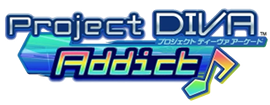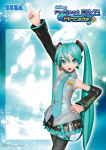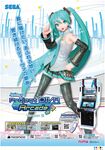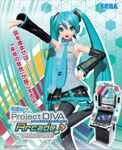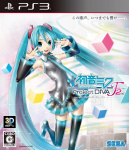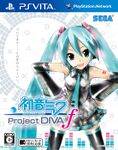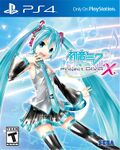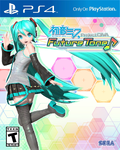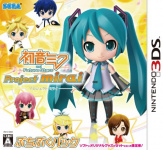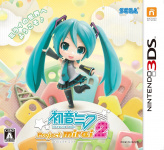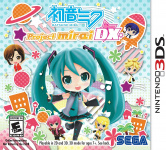Main Page: Difference between revisions
From Project DIVA Addict
m →Project Diva F & F2nd: Correction: Doubles are scored the same as before. The extra +200 is applied to all doubles that were not hit with the "lazy" method. Tag: Reverted |
→Games: Added mockup for Mega Mix |
||
| (21 intermediate revisions by the same user not shown) | |||
| Line 6: | Line 6: | ||
==Games== | ==Games== | ||
<div style="display:flex; flex-direction: row; flex-wrap: wrap"> | |||
[[File:Hatsune-Miku-Project-Diva- | <div style="padding:1em"> | ||
[[File:Hatsune-Miku-Project-Diva-Arcade.jpg|link=Project | <h3 style="text-align:center">Arcade</h3> | ||
[[File:Hatsune-Miku-Project-Diva-2nd.jpg|link=Project | [[File:Hatsune-Miku-Project-Diva-Arcade.jpg|link=Project DIVA Arcade|x150px|Project DIVA Arcade]] | ||
[[File:Hatsune-Miku-Project-Diva-Extend.jpg|link=Project | [[File:Hatsune-Miku-Project-Diva-Arcade-A.jpg|link=Project DIVA Arcade|x150px|Project DIVA Arcade Version A]] | ||
[[File:Hatsune-Miku-Project- | [[File:Hatsune-Miku-Project-Diva-Arcade-B.jpg|link=Project DIVA Arcade|x150px|Project DIVA Arcade Version B]] | ||
[[File:Hatsune-Miku-Project-Diva- | [[File:Hatsune-Miku-Project-Diva-Arcade-Future-Tone.jpg|link=Project DIVA Arcade|x150px|Project DIVA Arcade Future Tone]] | ||
[[File:Hatsune-Miku-Project- | </div> | ||
[[File:Hatsune-Miku-Project-Diva-F2.jpg|link=Project | |||
[[File:Hatsune-Miku-Project- | <div style="padding:1em"> | ||
[[File:Hatsune-Miku-Project-Diva-X.jpg|link=Project | <h3 style="text-align:center">PSP</h3> | ||
[[File:Hatsune-Miku-Project-Diva-Future-Tone.png|link=Project | [[File:Hatsune-Miku-Project-Diva-1st.jpg|link=Project DIVA (1st)|x150px|Project DIVA (1st)]] | ||
[[File:Hatsune-Miku-Project-Diva-2nd.jpg|link=Project DIVA 2nd|x150px|Project DIVA 2nd]] | |||
[[File:Hatsune-Miku-Project-Diva-Extend.jpg|link=Project DIVA Extend|x150px|Project DIVA Extend]] | |||
</div> | |||
<div style="padding:1em"> | |||
<h3 style="text-align:center">PS3</h3> | |||
[[File:Hatsune-Miku-Project-Diva-F1.jpg|link=Project DIVA F (1st)|x150px|Project DIVA F]] | |||
[[File:Hatsune-Miku-Project-Diva-F2.jpg|link=Project DIVA F 2nd|x150px|Project DIVA F 2nd]] | |||
</div> | |||
<div style="padding:1em"> | |||
<h3 style="text-align:center">PS Vita</h3> | |||
[[File:Hatsune-Miku-Project-DIVA-f1.jpg|link=Project DIVA F (1st)|x150px|Project DIVA F]] | |||
[[File:Hatsune-Miku-Project-Diva-F2-Vita.jpg|link=Project DIVA F 2nd|x150px|Project DIVA F 2nd]] | |||
[[File:Hatsune-Miku-Project-Diva-X-Vita.jpg|link=Project DIVA X|x150px|Project DIVA X]] | |||
</div> | |||
<div style="padding:1em"> | |||
<h3 style="text-align:center">PS4</h3> | |||
[[File:Hatsune-Miku-Project-Diva-X-PS4.jpg|link=Project DIVA X|x150px|Project DIVA X]] | |||
[[File:Hatsune-Miku-Project-Diva-Future-Tone.png|link=Project DIVA Future Tone|x150px|Project DIVA Future Tone]] | |||
</div> | |||
<div style="padding:1em"> | |||
<h3 style="text-align:center">3DS</h3> | |||
[[File:Hatsune-Miku-Project-Mirai-1.jpg|link=Project Mirai|x150px|Project Mirai (1)]] | |||
[[File:Hatsune-Miku-Project-Mirai-2.jpg|link=Project Mirai 2|x150px|Project Mirai 2]] | |||
[[File:Hatsune-Miku-Project-Mirai-DX.jpg|link=Project Mirai DX|x150px|Project Mirai DX]] | |||
</div> | |||
<div style="padding:1em"> | |||
<h3 style="text-align:center">Switch</h3> | |||
[[File:Hatsune-Miku-Project-Diva-Mega-39s.jpg|link=Project DIVA Mega 39s|x150px|Project DIVA Mega 39s]] | |||
[[File:Hatsune-Miku-Project-Diva-Mega-Mix.jpg|link=Project DIVA Mega 39s|x150px|Project DIVA Mega 39s]] | |||
</div> | |||
<div style="padding:1em"> | |||
<h3 style="text-align:center">Steam</h3> | |||
[[File:Hatsune-Miku-Project-Diva-Mega-Mix+.jpg|link=Project DIVA Mega Mix+|x150px|Project DIVA Mega Mix+]] | |||
</div> | |||
</div> | |||
==Songs== | |||
The Project DIVA franchise includes over 300 unique songs across all of its various its various iterations. Project DIVA Arcade (and by extension, Future Tone and Mega 39's/Mega Mix) receives the bulk of these songs. Some remain exlusive to the Project Mirai series and Project Diva X. | |||
For a comprehensive list of all songs available and which games they appeared in, see [[Songs]]. | |||
==Cross-Region Play== | |||
The PSP has no region locking for games, and thus JP games can be physically imported and played on PSPs from any region. | |||
The PS Vita had region locking capabilities, but no games utilized it, so JP games can be physically imported and played on any PS Vita system. | |||
The PS3 and PS4 have region locking capabilities, but very few games use it. Project DIVA games can be physically imported and played on any PS3 or PS4 system. | |||
Nintndo's DS systems '''''are''''' region locked, requiring a JP system to play JP games and an NA system to play NA games. Of particular note, however, is that most Asian countries are actually part of the same region as North America. This does not include Japan, which is its own region. | |||
The Nintendo Switch is region-free. | |||
===Digital Downloads=== | |||
For all systems mentioned above (excluding the DS series) it is possible to create a system account tied to a JP store account even if the system is for another region. The JP account can purchase JP content and download it to the system, and all system accounts can play that content as long as the purchasing account remains actively tied to the system. Sadly, the PSP and PS Vita only support having a single account tied to the system. But for the PS3, PS4, and Switch, you can create an account solely for the acquisition of JP content and use your main account to play said content. | |||
==Controls== | |||
[[Image:Operation board of Hatsune Miku Project DIVA Arcade Future Tone Version A 20150327.jpg|thumb|Arcade layout for Project DIVA Arcade Future Tone]] | |||
With the heavy tie to Sony's home consoles and portables, Project DIVA adopts Sony's trademarked triangle/square/cross/circle icons into its game play. | |||
For the home versions (excluding the original Project DIVA on PSP) the d-pad doubles as an extra set of buttons to facillitate some of the rapid button pressing required of some of the songs. Some notes are "doubles" which require you to press both the button and the corresponding d-pad direction together. Of particular note here is that Sega's coding was a bit lazy and players discovered that the d-pad and button didn't have to be pressed simultaneously. Rather, one could hold the d-pad down first and then press the required button (or vice versa). Sega addressed this in the Project DIVA F games by including a bonus for actually hitting the two simultaneously. This allowed players to keep using the easier way of inputting doubles if they wanted to, but encouraged players to press the buttons as intended instead. | |||
For the arcade, the layout is "unravelled" into a straight line going counter-clockwise from the Sony Dualshock diamond layout. In order to hit rapid notes, players can either use one hand and rely on their wrist for rapid movement, or they can bring both hands over one button and alternate between hands. Future Tone is an update to the original arcade layout that includes a slider above the buttons. The timing for slider actions is more forgiving than the timing for button presses -- COOL and FINE timing are turned into COOL for sliders, and SAFE and SAD are turned into FINE. | |||
See also: [[Custom Controller]] | |||
For the Project Mirai series, the game adopts Nintendo's XYBA layout with correlating colors. The game allows you to switch the color scheme to that of Sony's buttons. It also allows you to swap XYBA for up/left/down/right arrows instead. The colors and icon set selection are seperate from each other. | |||
==Gameplay== | ==Gameplay== | ||
| Line 58: | Line 137: | ||
Notes: | Notes: | ||
* Project | * Project DIVA 1st only has Easy, Normal, and Hard difficulties. | ||
* Only Project | * Only Project DIVA Arcade/Future Tone have the Extra Extreme difficulty. | ||
* For Project | * For Project DIVA Arcade/Future Tone, Easy and Normal difficulties have a Challenge Time that temporarily bumps up the difficulty. | ||
===Scoring=== | ===Scoring=== | ||
| Line 66: | Line 145: | ||
The accuracy of the player's timing is judged on a scale: COOL, FINE/GOOD, SAFE, SAD/BAD, and WORST/AWFUL. | The accuracy of the player's timing is judged on a scale: COOL, FINE/GOOD, SAFE, SAD/BAD, and WORST/AWFUL. | ||
In all games except Project | In all games except Project DIVA X, there is a combo bonus that grows until the 50th note in the combo. | ||
===Chance Time=== | ===Chance Time=== | ||
| Line 74: | Line 153: | ||
Chance Time has worked differently throughout the series. | Chance Time has worked differently throughout the series. | ||
====Project | ====Project DIVA (1st)==== | ||
An extra bonus is applied to notes in a combo inside Chance Time. This bonus starts at +100 for the first note in a combo within Chance Time and grows to a max of +5000 for the 50th note in the combo. Every note in the combo after the 50th maintains a +5000 bonus. If a note is missed, the combo is broken and the bonus starts at +100 again. The number displayed at the end of Chance Time is the bonus the player earned while inside Chance Time. Maintaining a combo inside Chance Time is extremely crucial to getting a good score. | An extra bonus is applied to notes in a combo inside Chance Time. This bonus starts at +100 for the first note in a combo within Chance Time and grows to a max of +5000 for the 50th note in the combo. Every note in the combo after the 50th maintains a +5000 bonus. If a note is missed, the combo is broken and the bonus starts at +100 again. The number displayed at the end of Chance Time is the bonus the player earned while inside Chance Time. Maintaining a combo inside Chance Time is extremely crucial to getting a good score. | ||
====Project | ====Project DIVA 2nd & Extend==== | ||
An extra bonus is applied to notes hit within Chance Time. This bonus is +1000 for COOLs and +600 for FINEs. Doubles are scored the same as singles. There is an extra bonus at the end of Chance Time that is awarded in increments of 10,000 based on the percentage of notes hit within Chance Time, with a max of 50,000 for a "perfect" Chance Time. | An extra bonus is applied to notes hit within Chance Time. This bonus is +1000 for COOLs and +600 for FINEs. Doubles are scored the same as singles. There is an extra bonus at the end of Chance Time that is awarded in increments of 10,000 based on the percentage of notes hit within Chance Time, with a max of 50,000 for a "perfect" Chance Time. | ||
====Project | ====Project DIVA F & F2nd==== | ||
An extra bonus is applied to notes hit within Chance Time. This bonus is +1000 for COOLs and +600 for FINEs. There is no extra bonus at the end of Chance Time. Chance Time success is gauged by a star icon that fills up on hit notes as Chance Time progresses. If the gauge is filled and the player hits the final Star Note at the end, an alternate PV sequence is unlocked. | An extra bonus is applied to notes hit within Chance Time. This bonus is +1000 for COOLs and +600 for FINEs. There is no extra bonus at the end of Chance Time. Chance Time success is gauged by a star icon that fills up on hit notes as Chance Time progresses. If the gauge is filled and the player hits the final Star Note at the end, an alternate PV sequence is unlocked. | ||
====Project | ====Project DIVA X==== | ||
No bonuses are given during Chance Time. Chance Time success is gauged by a star icon that fills up on hit notes as Chance Time progresses. If the Star Gauge is filled and the player hits the final note in Chance Time, the player will either unlock a random module (in Quest Mode) or switch modules in the middle of play (in Free Play, predetermined by the player at the song confirmation screen). | No bonuses are given during Chance Time. Chance Time success is gauged by a star icon that fills up on hit notes as Chance Time progresses. If the Star Gauge is filled and the player hits the final note in Chance Time, the player will either unlock a random module (in Quest Mode) or switch modules in the middle of play (in Free Play, predetermined by the player at the song confirmation screen). | ||
| Line 108: | Line 187: | ||
In Project DIVA 2nd and Extend, rank is determined by the percentage of notes you hit with either COOL or FINE. | In Project DIVA 2nd and Extend, rank is determined by the percentage of notes you hit with either COOL or FINE. | ||
==== | ====Grade Point System==== | ||
In Project DIVA F, F 2nd, and X, Rank is determined by | In Project DIVA F, F 2nd, and X, Rank is determined by Grade Points. | ||
{| class="wikitable" | {| class="wikitable" | ||
Latest revision as of 04:45, 8 June 2022
From Wikipedia:
Hatsune Miku: Project DIVA is a series of rhythm games created by Sega and Crypton Future Media. The games have appeared on the PSP, Vita, PS3, and PS4. The series primarily makes use of Crypton Future Media's Vocaloids. The game is the first video game to utilize the Vocaloid software developed by the Yamaha Corporation.
Hatsune Miku: Project Mirai is a series of rhythm games created by Sega and Crypton Future Media for the 3DS. Core game play is similar to Project DIVA. The Project Mirai series features chibi versions of Crypton Future Media's Vocaloids and utilizes a different note track system. Gameplay is notably not as difficult as in Project DIVA. The series also features a guest-star Vocaloid (GUMI) from Internet Co., Ltd.
Games
Songs
The Project DIVA franchise includes over 300 unique songs across all of its various its various iterations. Project DIVA Arcade (and by extension, Future Tone and Mega 39's/Mega Mix) receives the bulk of these songs. Some remain exlusive to the Project Mirai series and Project Diva X.
For a comprehensive list of all songs available and which games they appeared in, see Songs.
Cross-Region Play
The PSP has no region locking for games, and thus JP games can be physically imported and played on PSPs from any region.
The PS Vita had region locking capabilities, but no games utilized it, so JP games can be physically imported and played on any PS Vita system.
The PS3 and PS4 have region locking capabilities, but very few games use it. Project DIVA games can be physically imported and played on any PS3 or PS4 system.
Nintndo's DS systems are region locked, requiring a JP system to play JP games and an NA system to play NA games. Of particular note, however, is that most Asian countries are actually part of the same region as North America. This does not include Japan, which is its own region.
The Nintendo Switch is region-free.
Digital Downloads
For all systems mentioned above (excluding the DS series) it is possible to create a system account tied to a JP store account even if the system is for another region. The JP account can purchase JP content and download it to the system, and all system accounts can play that content as long as the purchasing account remains actively tied to the system. Sadly, the PSP and PS Vita only support having a single account tied to the system. But for the PS3, PS4, and Switch, you can create an account solely for the acquisition of JP content and use your main account to play said content.
Controls
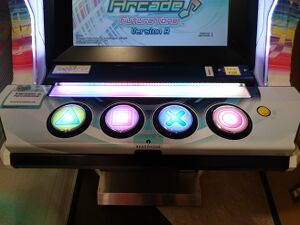
With the heavy tie to Sony's home consoles and portables, Project DIVA adopts Sony's trademarked triangle/square/cross/circle icons into its game play.
For the home versions (excluding the original Project DIVA on PSP) the d-pad doubles as an extra set of buttons to facillitate some of the rapid button pressing required of some of the songs. Some notes are "doubles" which require you to press both the button and the corresponding d-pad direction together. Of particular note here is that Sega's coding was a bit lazy and players discovered that the d-pad and button didn't have to be pressed simultaneously. Rather, one could hold the d-pad down first and then press the required button (or vice versa). Sega addressed this in the Project DIVA F games by including a bonus for actually hitting the two simultaneously. This allowed players to keep using the easier way of inputting doubles if they wanted to, but encouraged players to press the buttons as intended instead.
For the arcade, the layout is "unravelled" into a straight line going counter-clockwise from the Sony Dualshock diamond layout. In order to hit rapid notes, players can either use one hand and rely on their wrist for rapid movement, or they can bring both hands over one button and alternate between hands. Future Tone is an update to the original arcade layout that includes a slider above the buttons. The timing for slider actions is more forgiving than the timing for button presses -- COOL and FINE timing are turned into COOL for sliders, and SAFE and SAD are turned into FINE.
See also: Custom Controller
For the Project Mirai series, the game adopts Nintendo's XYBA layout with correlating colors. The game allows you to switch the color scheme to that of Sony's buttons. It also allows you to swap XYBA for up/left/down/right arrows instead. The colors and icon set selection are seperate from each other.
Gameplay
The core goal in the series is to hit buttons in rhythm to the Vocaloids' singing. During extended vocal breaks, the player may be required to press buttons to the rhythm of the background music.
The buttons the player needs to hit, and their timing, are indicated by an icon & target system.
Players can select from five difficulties:
| Difficulty | All Versions | Project DIVA home versions | Project DIVA Arcade/Future Tone |
|---|---|---|---|
| Easy | Notes appear infrequently No/Minimum note switching |
Single button only (Circle) | Circle and Cross Only, no Multi-Notes |
| Normal | Notes appear normally Minimum note-switching |
PSP: Always Circle and Cross Vita/PS3/PS4: Circle and one other button |
All four buttons, no Multi-Notes |
| Hard | Notes appear frequently Regular note-switching |
All four buttons | All four buttons, some Multi-Notes |
| Extreme | Notes appear very frequently Frequent note-switching |
All four buttons | All four buttons, frequent Multi-notes |
| Extra Extreme | Notes appear very frequently Very frequent note-switching |
N/A | All four buttons, very frequent Multi-notes |
Notes:
- Project DIVA 1st only has Easy, Normal, and Hard difficulties.
- Only Project DIVA Arcade/Future Tone have the Extra Extreme difficulty.
- For Project DIVA Arcade/Future Tone, Easy and Normal difficulties have a Challenge Time that temporarily bumps up the difficulty.
Scoring
The accuracy of the player's timing is judged on a scale: COOL, FINE/GOOD, SAFE, SAD/BAD, and WORST/AWFUL.
In all games except Project DIVA X, there is a combo bonus that grows until the 50th note in the combo.
Chance Time
Chance Time is a feature of all home versions of Project DIVA. A player's life gauge is not affected during Chance Time.
Chance Time has worked differently throughout the series.
Project DIVA (1st)
An extra bonus is applied to notes in a combo inside Chance Time. This bonus starts at +100 for the first note in a combo within Chance Time and grows to a max of +5000 for the 50th note in the combo. Every note in the combo after the 50th maintains a +5000 bonus. If a note is missed, the combo is broken and the bonus starts at +100 again. The number displayed at the end of Chance Time is the bonus the player earned while inside Chance Time. Maintaining a combo inside Chance Time is extremely crucial to getting a good score.
Project DIVA 2nd & Extend
An extra bonus is applied to notes hit within Chance Time. This bonus is +1000 for COOLs and +600 for FINEs. Doubles are scored the same as singles. There is an extra bonus at the end of Chance Time that is awarded in increments of 10,000 based on the percentage of notes hit within Chance Time, with a max of 50,000 for a "perfect" Chance Time.
Project DIVA F & F2nd
An extra bonus is applied to notes hit within Chance Time. This bonus is +1000 for COOLs and +600 for FINEs. There is no extra bonus at the end of Chance Time. Chance Time success is gauged by a star icon that fills up on hit notes as Chance Time progresses. If the gauge is filled and the player hits the final Star Note at the end, an alternate PV sequence is unlocked.
Project DIVA X
No bonuses are given during Chance Time. Chance Time success is gauged by a star icon that fills up on hit notes as Chance Time progresses. If the Star Gauge is filled and the player hits the final note in Chance Time, the player will either unlock a random module (in Quest Mode) or switch modules in the middle of play (in Free Play, predetermined by the player at the song confirmation screen).
Challenge Time
Challenge Time is a feature of Project DIVA Arcade/Future Tone. It only appears on Easy and Normal difficulties. Difficulty is temporarily increased. A player's life gauge is not affected during Challenge time.
Technical Zones
Technical Zones were introduced in Project DIVA F. A player must hit all the notes inside a Technical Zone to pass it.
Rank
Rank is the result you get at the end of a song. MIS✕TAKE/DROP✕OUT, CHEAP/LOUSY, STANDARD, GREAT, EXCELLENT, and PERFECT.
Note: Project DIVA (1st) did not have an EXCELLENT rank.
In Project DIVA (1st) and Arcade/Future Tone, rank is determined by your score as a percentage of a max score.
In Project DIVA 2nd and Extend, rank is determined by the percentage of notes you hit with either COOL or FINE.
Grade Point System
In Project DIVA F, F 2nd, and X, Rank is determined by Grade Points.
| % of successful note hits × 89 | 89 |
| Chance Time Successful | 5 |
| % of Completed Technical Zones × 6 | 6 |
| TOTAL RANK POINTS | 100 |
Technical Specifications
| Games | Resolution | Frame rate | Frame dropping |
|---|---|---|---|
| Project DIVA PSP games | 480x272 | 30fps | Yes |
| Project DIVA PS Vita games | 960x544 | 30fps | Extremely Minimal |
| Project DIVA Arcade | 720p | 60fps | No |
| Project DIVA Dreamy Theater games | 720p | 60fps | No |
| Project DIVA F PS3 games | 1080p | 30fps | Extremely Minimal |
| Project DIVA PS4 games | 1080p | 60fps | No |
